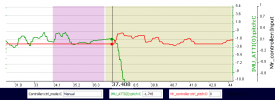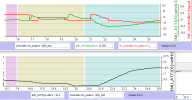- Joined
- Nov 23, 2021
- Messages
- 142
- Reaction score
- 29
- Age
- 70
Getting better each time. This time I got in a solid 8 minutes of FPV Manual time. This time, I paid attention to how long it took me from engine start, and then climb up 300 ft to my switchover point, and throw the switch. 30 seconds. So I decided to come home and hit the Brake at 8:30, which was about as low as I wanted to get in terms of battery power anyhow. It’s a lot more conservative than I am about deciding what “low power” means! But once I tell it to ignore it, it does.
I expect that from this point forward, my flights will get shorter, rather than longer, because I’ll be going a little faster each time…
It told me again to tighten the throttle stick. Why would it do that? How would it have any clue how stiff they are? I’m pretty happy with the current setting, although a little stiffer wouldn’t hurt. I’m definitely going to tighten up the right stick a bit. The biggest “uncommanded annoyance” is when it starts to drift backward. Now, tilting the nose down a bit to arrest that is natural at this point, but I’d like to keep it from drifting that way by default. Clearly, the center position of the right stick lets it drift backward, when I don’t intend it. If I tighten it up a bit, it should stop doing that.
Setting the camera at a fixed orientation and leaving it there does indeed help. I’ve re-programmed my brain to think of the camera image as my attitude indicator, as long as I leave it fixed. I’ve also evolved my understanding of what the sticks do. Knowing that it’s an oversimplification, I treat the left stick as my vertical speed control, and the right stick as my forward/reverse control. Works good! The actual motions are a bit more nuanced than that, but what’s happening is that my fingers are just figuring out what to do, and then after the fact, I observe what I did. Not many more flights, and I’ll be able to describe that a little better.
For a long-time fixed wing pilot like me, one way to explain the value of putting the camera in one place and leaving it alone, could be to ask the simple question, “Do you want an attitude indicator, or not?” I think that makes the point pretty clearly. I’m sure I’ll diddle with the camera from time to time, but for the most part, I’m going to leave set it and leave it where it is while I’m still in my early learning. Good advice!
More than once, I’ve found myself wishing I could hear the sound of the engines in flight. Sometimes I can…if I’m not too far away!
I was able to get it to sort of hover, after a fashion, by cheating. This was the first time that I’ve flown in Manual mode when there was non-trivial wind. I was able to keep it roughly in the same place by flying into a 10-12 mph wind. My objective now is to fly a little more slowly, but also more steadily. The wind will only get worse as the day wears on, so that was my last FPV Manual flight for today. On my first flight tomorrow, I plan to just do laps up and down the canyon, from here down to the Flag, and improving my control each time, and as I improve my control, increase my speed.
I did see 70 mph briefly, but that just sort of happened during an…excursion…followed by a recovery. It seemed to have more of a tendency to roll to the left without me telling it to on this flight. Wind, perhaps? I’m paying more attention to coordinating the turns, and that has significantly enhanced my directional control!
The Beast definitely does a major shake, rattle and roll when I hit the Brake button! I’m used to it now, but it’s still a bit surprising.
My biggest on-going screw-up isn’t in Manual mode per se. When I shift back to Normal mode for landing, I don’t automatically account for the stiffness of the left stick, and I expect it to re-center on its own. I catch it and correct it quickly, but that’s a bad habit that I need to break.
It wouldn’t do at all for me to successfully terrorize the skies in Manual, just to plop it into the sagebrush in Normal when I’m on final for landing!

I expect that from this point forward, my flights will get shorter, rather than longer, because I’ll be going a little faster each time…
It told me again to tighten the throttle stick. Why would it do that? How would it have any clue how stiff they are? I’m pretty happy with the current setting, although a little stiffer wouldn’t hurt. I’m definitely going to tighten up the right stick a bit. The biggest “uncommanded annoyance” is when it starts to drift backward. Now, tilting the nose down a bit to arrest that is natural at this point, but I’d like to keep it from drifting that way by default. Clearly, the center position of the right stick lets it drift backward, when I don’t intend it. If I tighten it up a bit, it should stop doing that.
Setting the camera at a fixed orientation and leaving it there does indeed help. I’ve re-programmed my brain to think of the camera image as my attitude indicator, as long as I leave it fixed. I’ve also evolved my understanding of what the sticks do. Knowing that it’s an oversimplification, I treat the left stick as my vertical speed control, and the right stick as my forward/reverse control. Works good! The actual motions are a bit more nuanced than that, but what’s happening is that my fingers are just figuring out what to do, and then after the fact, I observe what I did. Not many more flights, and I’ll be able to describe that a little better.
For a long-time fixed wing pilot like me, one way to explain the value of putting the camera in one place and leaving it alone, could be to ask the simple question, “Do you want an attitude indicator, or not?” I think that makes the point pretty clearly. I’m sure I’ll diddle with the camera from time to time, but for the most part, I’m going to leave set it and leave it where it is while I’m still in my early learning. Good advice!
More than once, I’ve found myself wishing I could hear the sound of the engines in flight. Sometimes I can…if I’m not too far away!
I was able to get it to sort of hover, after a fashion, by cheating. This was the first time that I’ve flown in Manual mode when there was non-trivial wind. I was able to keep it roughly in the same place by flying into a 10-12 mph wind. My objective now is to fly a little more slowly, but also more steadily. The wind will only get worse as the day wears on, so that was my last FPV Manual flight for today. On my first flight tomorrow, I plan to just do laps up and down the canyon, from here down to the Flag, and improving my control each time, and as I improve my control, increase my speed.
I did see 70 mph briefly, but that just sort of happened during an…excursion…followed by a recovery. It seemed to have more of a tendency to roll to the left without me telling it to on this flight. Wind, perhaps? I’m paying more attention to coordinating the turns, and that has significantly enhanced my directional control!
The Beast definitely does a major shake, rattle and roll when I hit the Brake button! I’m used to it now, but it’s still a bit surprising.
My biggest on-going screw-up isn’t in Manual mode per se. When I shift back to Normal mode for landing, I don’t automatically account for the stiffness of the left stick, and I expect it to re-center on its own. I catch it and correct it quickly, but that’s a bad habit that I need to break.
It wouldn’t do at all for me to successfully terrorize the skies in Manual, just to plop it into the sagebrush in Normal when I’m on final for landing!




